ABT Framework Student Resource Page
Round 13
Contents
Sign up to participate in Working Circles (Separate Page)
Download Previous Chat Logs (Separate Page)
Session 1 Resources – Outer Circle
Session 2 Resources – Singular Narrative
Session 3 Resources – Hero’s Journey
Session 4 Resources – Three Act Structure
Session 5 Resources – Listening with Brian Palermo
Session 6 Resources – Shifting Baselines with Patty Limerick
Session 7 Resources – Audience as Hero with Park Howell and Elizabeth Stulberg
Session 8 Resources – Genuflect to the Elders with Dianna Padilla
Session 9 Resources – Obfuscation with Mike Strauss
Session 10 Resources – Narrative Spiral with Nancy Knowlton
Synopsis on Working Circles – If you’re new to Working Circles, start by reading this.
Working Circle Half Hour Schedule – Use this to guide you through how to host your half hour Working Circle.
To complete the class, you must sign up to host 1 Working Circle and sign up to participate in 2 Working Circles.
Sign up to host a Working Circle
- Find an available half hour time slot on this page.
- Email mattmdavid@gmail.com to have your time slot reserved.
- Include the following in your email.
- Day
- Half hour time slot in Pacific Time (PDT).
- Short title for your Working Circle based on your ABT (feel free to make it catchy/fun/different if you want).
Host responsibilities
- Email your participants your ABT before the Working Circle so they have time to review it – we’ll send you the list of your participants’ email addresses 3-5 days ahead of time.
- You can send your participants a revised ABT of what you originally submitted to class or use a brand new ABT all together.
- During the Working Circle, use the ABT Blue Card and follow the half hour schedule.
- You’re the moderator of the discussion, so do your best to make sure everyone gets a chance to speak and provide input.
- We’ll send you and your participants a Webex link for your Working Circle 3-5 days before you’re scheduled to host, so no need to worry about that.
Participant responsibilities
- Sign up to participate in a minimum of 2 Working Circles. Sign up here.
- Review the ABT that the host sent you ahead of time.
- Be prepared to use the ABT Blue Card and all the tools you’ve learned in class to help the host clarify their narrative.
Sign up to host a Working Circle (see above)
Download the ABT Blue Card – Have it open or printed out and ready for each class.
Watch the AAAS video:
Session 1 Resources – Outer Circle
If you had an ABT Build session and want to get your notes from the chat, you can download previous chat logs here.
Optional Exercise #1: The 5 Word Problem
“What’s the problem?” is the most common question Randy asks during the ABT Builds. For this exercise, think of your ABT and try to finish this sentence “The problem is _____” and use only 5 additional words.
Examples: The problem is bad resource management.
The problem is the old method doesn’t work.
The problem is we have bad data.
Stripping down your problem to just 5 words can really help you clarify what your ABT is really all about.
Session 2 Resources – Singular Narrative
Week 1 Working Circles are available. Sign up to participate here.
Dr. Wenowdis:
Nicholas Kristof’s Advice for Saving the World – The importance of the singular narrative.
Session 3 Resources – Hero’s Journey
Matthew Winkler Video: What makes a hero? – We only watched the first two minutes in class. Watch this to the end to see how the hero’s journey applies to your life:
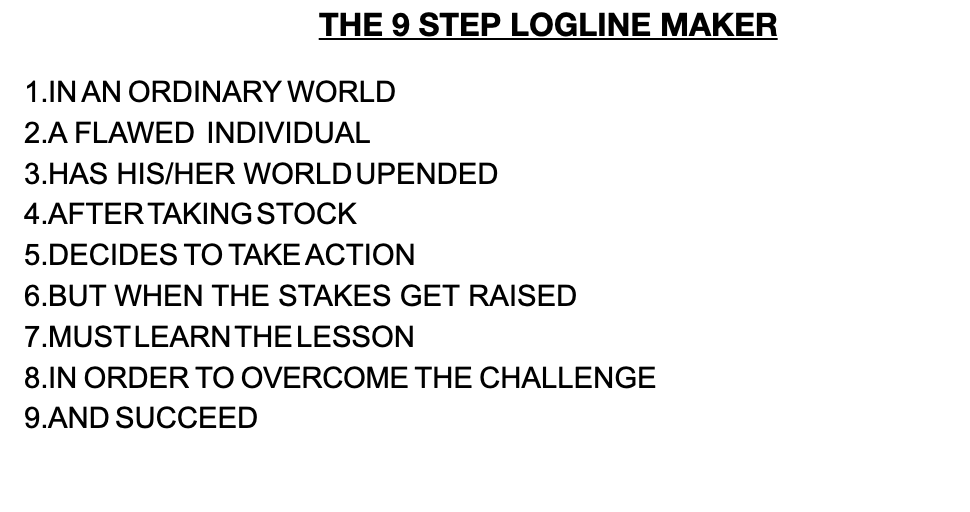
Oprah’s Golden Globes Speech – A great example of using Nested ABTs. Color coded in the ABT format.
Three Forms of the ABT – It’s recommended you read this article and get an understanding of the cABT (Conversational ABT).
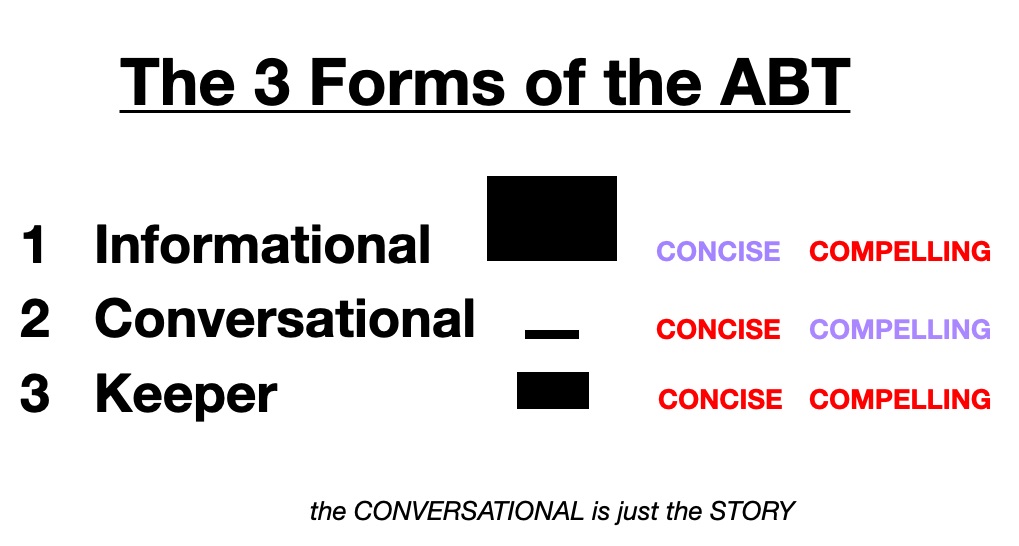
Optional Exercise #2: cABT
Randy might ask you the cABT version of your ABT, so you may want to prepare it ahead of time.
The cABT should have all specifics stripped off of it. Use nothing but generic words. For example, if your ABT dealt with a new way to clean junk from the ocean that’s an improvement and the old system is outdated, the cABT would be “We had a method we were using for a while, but it’s not working that great, so now we want to use a better one.”
See? We can’t tell that you’re working on cleaning the environment. You could just as well be telling me that you’re implementing a new accounting system at your bank for all we know. That makes it a good cABT – the specifics are stripped out, leaving just the base narrative. And then from the base cABT, you can start adding specifics again when constructing your kABT.
Session 4 Resources – Three Act Structure
Nancy Duarte – The Secret Structure of Great Talks:
Optional Exercise #3: Using the Dobzhansky Template to find your “One Thing.”
Restructure your ABT in the form of a Dobzhansky Template to help you find your singular narrative.
Dobzhansky Template: Nothing in _______ makes sense, except in the light of ________.
Examples: Nothing in biology makes sense, except in the light of evolution.
Nothing in geology makes sense, except in the light of plate tectonics.
Nothing in the management of mule deer makes sense except in the light of correctly estimating abundance.
Nothing in the challenge of teaching human anatomy makes sense except in the light of time management.
Session 5 Resources – Listening with Brian Palermo
Brian Palermo’s Resources – Brian offers a number of resource videos on his website, some with interactive exercises built in. Topics include listening, utilizing emotional intelligence, and audience focused communication. He also offers online improv training to help improve listening and communication skills.
Optional Exercise #4: Using IF/THEN to draw on the power of the future.
Read about using the IF/THEN tool in “The Narrative Gym” (Chapter 5, print pages 41 thru 47, pdf pages 47 thru 53. You should have been emailed a pdf copy at the beginning of the course. If you can’t find it, email mattmdavid@gmail.com for a replacement).
The IF/THEN tool isn’t applicable for all ABTs, but experiment and see if it is for yours. Try using a positive IF/THEN in the AND to help set the stakes to the Outer Circle of how great everything will be if it goes to plan. Or use a negative IF/THEN in the BUT to show the Outer Circle how bad things can be if everything goes astray. In either case, be as specific as you can to show the Outer Circle what is at stake if everything goes right or if everything goes wrong.
Session 6 Resources – Shifting Baselines with Patty Limerick
Slow-Motion Disaster Below the Waves – Randy’s LA Times article on Shifting Baselines.
The scariest thing about global warming (and Covid-19) – An article on the Shifting Baselines of Global Warning
The Legacy of Conquest: The Unbroken Past of the American West – Patty Limerick’s book that reshaped our views on the West.
Chaos in the brickyard – A famous Science Magazine letter on scientists and their obsessions.
Not My First Rodeo – Patty Limerick’s Blog
Dancing With Professors: The Trouble With Academic Prose – A New York Times article written by Patty Limerick in 1993 about the problems academics have with communication. Still relevant today!
Optional Exercise #5: Maximizing the “turn” into the problem: WHAT/HOW and impact words
Step 3 of the ABT Blue card talks about the WHAT and the HOW for your problem in the BUT, but what does that mean exactly?
Let’s look at this example ABT:
Our museum cares for over 200,000 museum objects and tell the story of this land and its people, BUT poor storage conditions with inadequate temperature, moisture and insect control are allowing deterioration of these special objects, THEREFORE we need to fund construction of a new building to halt degradation before these objects are lost.
In the BUT for this problem we have a WHAT and a HOW.
WHAT is the problem: deterioration of these special objects
HOW is it happening: poor storage conditions with inadequate temperature, moisture and insect control.
But in the above ABT, the WHAT and the HOW are reversed. You want to make sure the WHAT is at the start of the ABT to maximize the turn from the Ordinary World of the AND to the Special World of the BUT. Hit that audience as soon as possible with the WHAT of the problem so they know exactly what is happening asap. Don’t hide your headline until the end of the BUT and make your audience try to figure out where you’re going.
Example correction:
BUT these special museum objects are deteriorating due to poor storage conditions with inadequate temperature, moisture and insect control.
And finally, you want to use an impact word in the WHAT that is both accurate and powerful to really grab your audience and let them know what’s happening as directly as possible. In the above example, the impact word is deteriorating, which is good, but is there another word or phrase that might be better (this is where the “art” part of the ABT lies)?
Examples:
BUT these special museum objects are being destroyed
BUT these special museum objects are rotting
BUT these special museum objects are falling apart
BUT these special museum objects are decaying
Look at your own ABT. Make sure that you have the WHAT and the HOW in the correct order, and then look at your impact word and see if you can brainstorm any that might be both accurate and more powerful. This might be a good exercise to run through with your Working Circle!
Session 7 Resources – Audience as Hero with Park Howell and Elizabeth Stulberg
Park Howell’s Business of Storytelling Podcast – Randy has been feature on a number of Park’s podcasts. Here’s the most recent episode with Randy.
Brand Bewitchery: How to Wield the Story Cycle System to Craft Spellbinding Stories for Your Brand – Park Howell’s book on using the ABT and the Hero’s Journey to help market your brand.
Session 8 Resources – Genuflect to the Elders with Dianna Padilla
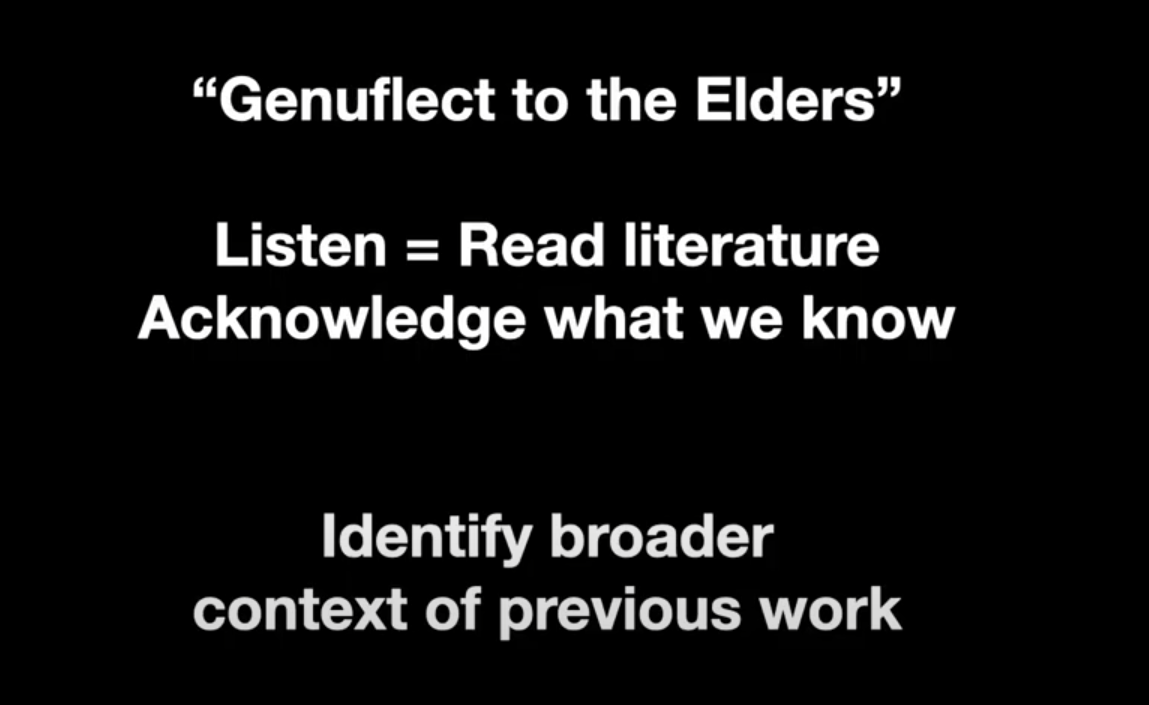
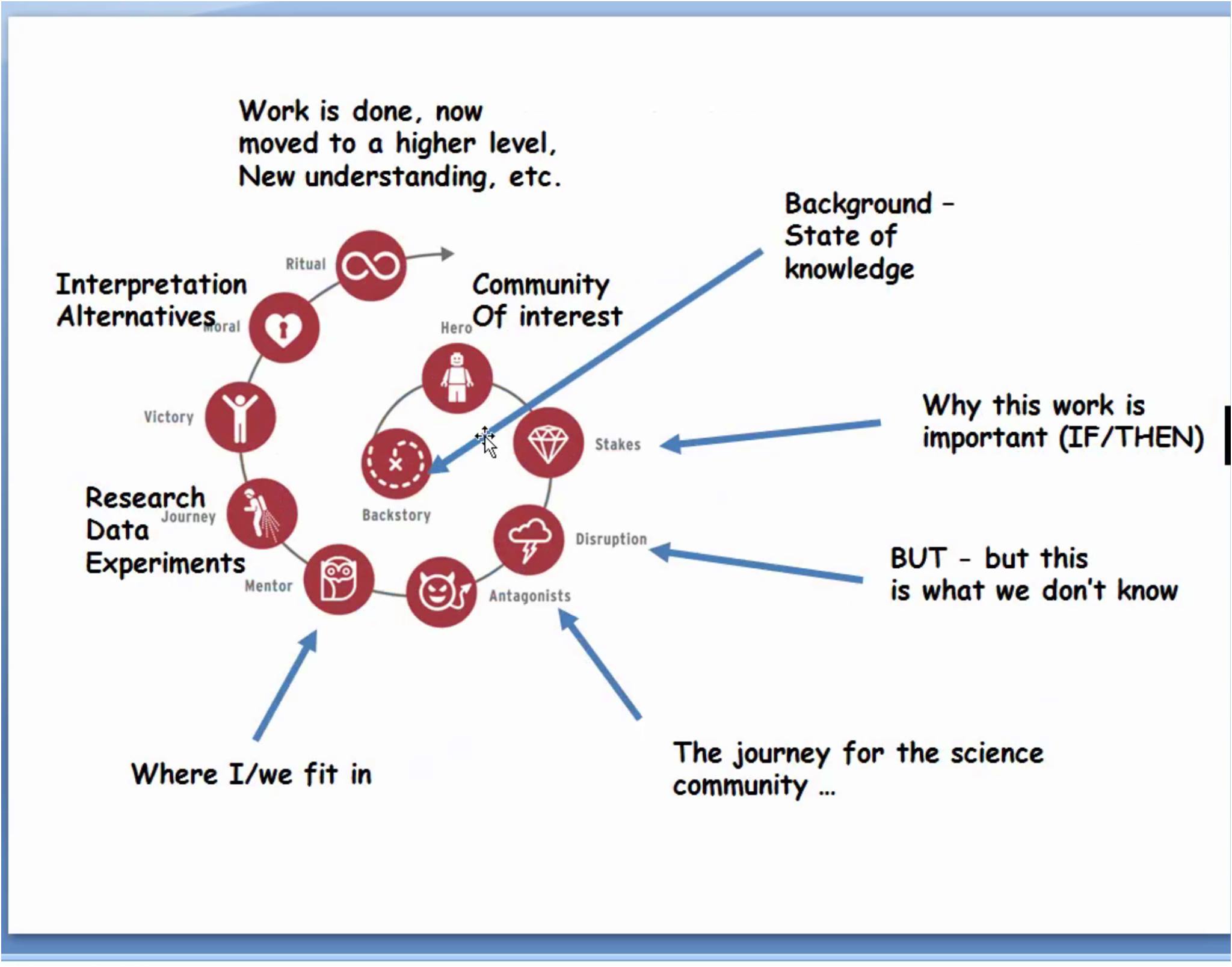
Advice on how women should pitch the “BUT” – A reply by Dianna to a former student’s question about the bias against women when they use the same strategies as men.
Are You Confused by Scientific Jargon? So Are Scientists – A New York Times article recommended by Dianna about how jargon clogs up scientific papers to the point that other scientists can’t understand them. Remember: your Inner Circle is always smaller than you think it is.
Session 9 Resources – Obfuscation with Mike Strauss
A Cure for Obfuscation:
Two Decades Ago Climate Communication Missed a Huge Opportunity – Randy’s article on the message that Michael Crichton was trying to deliver to the climate community, but was rejected.
Session 10 Resources – Narrative Spiral with Nancy Knowlton
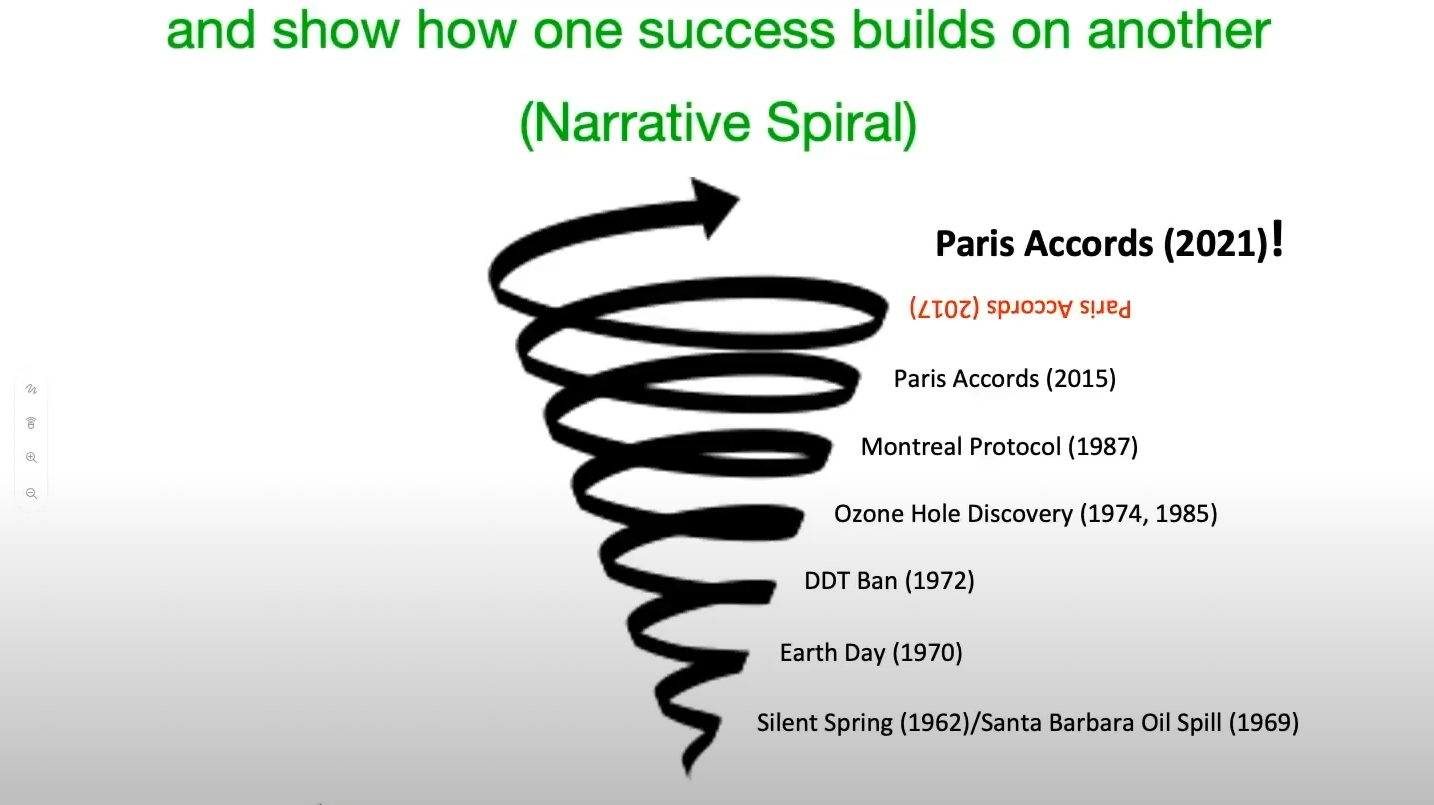
Individuals with greater science literacy and education have more polarized beliefs on controversial science topics – The paper Nancy referenced that shows how science literacy and political affiliation affect belief in controversial topics. Despite what scientists would like to believe, more information isn’t always the right answer.
UN climate reports are increasingly unreadable – This is what we’re fighting against.
Risk Communication on Climate: Mental Models and Mass Balance – The Abstract (which is a pretty good ABT, though it has multiple narratives – see if you can spot them) says it all: This article discusses risk communication on climate. The author notes that effective risk communication is grounded in deep understanding of the mental models of policy-makers and citizens. It is concluded that more research and technical innovation-money and genius are always in short supply. But there is no purely technical solution for climate change. For public policy to be grounded in the hard-won results of climate science, we must now turn our attention to the dynamics of social and political change.
Citizens of the Sea: Wondrous Creatures From the Census of Marine Life – Nancy Knowlton’s book.
Earth Optimism – A movement that Nancy is heavily involved in to help highlight the upward rise of the climate movement’s narrative spiral.
“They Say / I Say” – A book on arguing in an ABT-like style.
Uri Hasson’s Paper on Neurocinematics – For a look at how narrative and non-narrative affects the brain. This paper was referenced in the AAAS video.